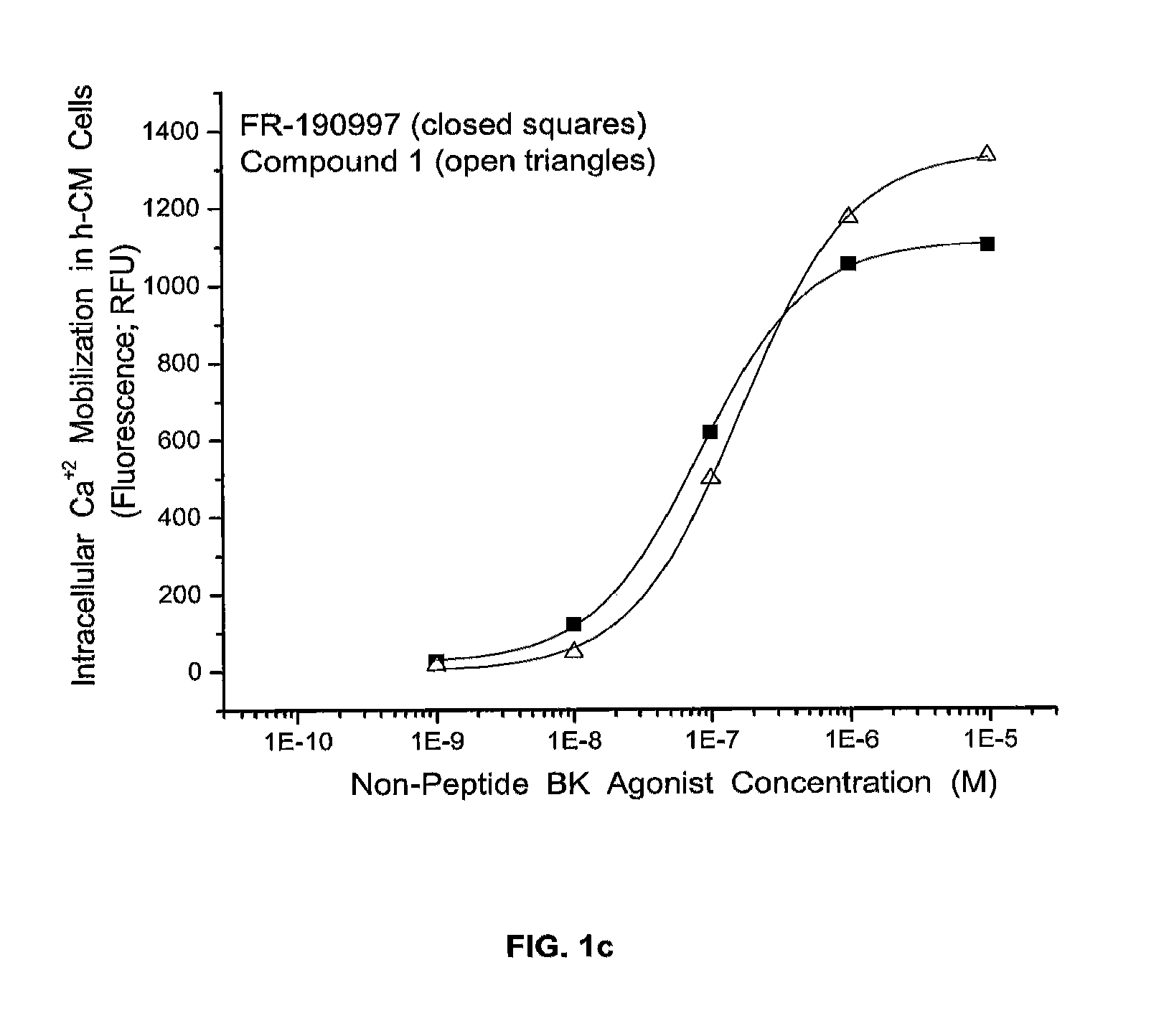Use of non-peptidic bradykinin receptor agonists to treat ocular hypertension and glaucoma
a non-peptidic bradykinin receptor and ocular hypertension technology, applied in the field of treating ocular disorders, can solve the problems of glaucomas still poorly understood, progressive visual loss and blindness, optic nerve damage, etc., and achieve the effect of treating and/or preventing an ocular condition
- Summary
- Abstract
- Description
- Claims
- Application Information
AI Technical Summary
Problems solved by technology
Method used
Image
Examples
example 1
Bradykinin and its Receptor mRNAs are Expressed in Relevant Ocular Cells and Tissues
[0097]Molecular biological techniques were used to demonstrate the presence of mRNAs for the precursor protein for BK (kininogen) and the two receptors for BK (B1- and B2-types) in numerous human ocular tissues and cells including relatively high levels in the most relevant ones involved in aqueous humor dynamics and IOP modulation, namely TM and CB (Tables 1 and 2).
[0098]
TABLE 1Microarray Analysis of BK Precursor (Kinnogen) and BK Receptor mRNAsExpression in Normal Human Ocular TissuesNormalized Levels of mRNAs(normalized expression based on GC-RMA algorithm)TissueKininogenB1-ReceptorB2-ReceptorTrabecular0.920.51.04meshworkCiliary body0.90.91.09Optic nerve head1.140.530.96Sclera0.630.452.47Iris0.690.51.1Lens0.650.420.72Optic nerve0.640.420.61Choroid0.630.420.91Cornea0.610.481.6Retina0.490.430.54
[0099]
TABLE 2Microarray Analysis of BK Precursor(Kinnogen) and BK Receptor mRNAsExpression in Normal and G...
example 2
Functional Bradykinin Receptor are Expressed in Relevant Ocular Cells and Tissues
[0102]While the detection of mRNAs for kininogen and both B1- and B2-receptors and their modulation by TGF-β2 was considered important, the demonstration of the existence of the functional receptor proteins in the IOP-modulating cells was critical. Accordingly, we discovered and pharmacologically characterized B2-receptor proteins in h-TM, h-CM and h-NPE cells coupled to the enzyme phospholipase C. The activation of these B2-receptors by BK, BK-analogs and the non-peptide BK-mimetics, FR-190997 and compound 1, resulted in the generation of intracellular second messengers, inositol phosphates, which in turn mobilized [Ca2+]i in these cells (Table 4; FIG. 1a,b).
[0103]
TABLE 4Functional Agonist Potency and Intrinsic Activity of BK-, BK-related Peptides- and FR-190997-induced[Ca2+]i Mobilization in Human TM, CM, and NPE CellsPotency (EC50; nM) andIntrinsic Activity (Emax, % max relative to BK)Compoundh-TM Ce...
example 3
Non-Peptide Bradykinin Agonists Lower IOP in Monkey Eyes
[0108]It was important to first demonstrate that the parent peptide bradykinin (BK) could lower IOP. Since peptides such as BK do not readily penetrate the cornea when administered topical ocularly, rabbit studies employed another route of administration. Thus, as shown in FIG. 3a, intravitreally administered BK (50 ng) profoundly lowered rabbit IOP relative to the effect of the vehicle alone. These results provided evidence that activation of the BK receptor caused ocular hypotension.
[0109]Since initial studies indicated that non-peptidic BK agonists lowered IOP in ocular hypertensive monkey eyes when administered topical ocularly, all subsequent studies in the monkeys utilized this route of administration. Thus, the non-peptide BK-mimetics, FR-190997 and Compound 1, when dosed topical ocularly to conscious ocular hypertensive eyes of cynomolgus monkeys produced significant dose-dependent lowering of IOP (0.03-600 μg / eye) (Tab...
PUM
| Property | Measurement | Unit |
|---|---|---|
| wt % | aaaaa | aaaaa |
| volume | aaaaa | aaaaa |
| pH | aaaaa | aaaaa |
Abstract
Description
Claims
Application Information
 Login to View More
Login to View More - R&D
- Intellectual Property
- Life Sciences
- Materials
- Tech Scout
- Unparalleled Data Quality
- Higher Quality Content
- 60% Fewer Hallucinations
Browse by: Latest US Patents, China's latest patents, Technical Efficacy Thesaurus, Application Domain, Technology Topic, Popular Technical Reports.
© 2025 PatSnap. All rights reserved.Legal|Privacy policy|Modern Slavery Act Transparency Statement|Sitemap|About US| Contact US: help@patsnap.com



